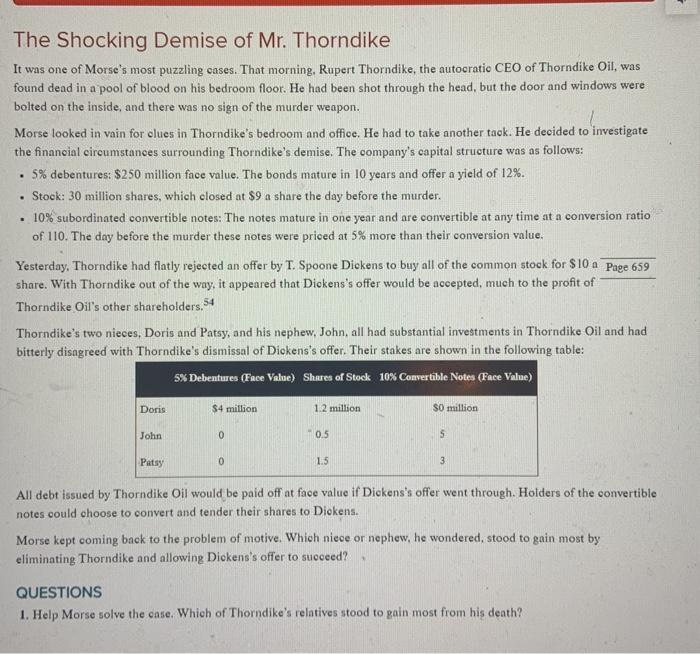. The Shocking Demise of Mr. Thorndike It was one of Morse's most puzzling cases. That morning, Rupert Thorndike, the autocratic CEO of Thorndike Oil, was found dead in a pool of blood on his bedroom floor. He had been shot through the head, but the door and windows were bolted on the inside, and there was no sign of the murder weapon. Morse looked in vain for clues in Thorndike's bedroom and office. He had to take another tack. He decided to investigate the financial circumstances surrounding Thorndike's demise. The company's capital structure was as follows: 5% debentures: $250 million face value. The bonds mature in 10 years and offer a yield of 12%. Stock: 30 million shares, which closed at $9 a share the day before the murder. 10% subordinated convertible notes: The notes mature in one year and are convertible at any time at a conversion ratio of 110. The day before the murder these notes were priced at 5% more than their conversion value. Yesterday, Thorndike had flatly rejected an offer by T. Spoone Dickens to buy all of the common stock for $10 a Page 659 share. With Thorndike out of the way, it appeared that Dickens's offer would be accepted, much to the profit of Thorndike Oil's other shareholders.54 Thorndike's two nieces, Doris and Patsy, and his nephew, John, all had substantial investments in Thorndike Oil and had bitterly disagreed with Thorndike's dismissal of Dickens's offer. Their stakes are shown in the following table: 5% Debentures (Face Value) Shares of Stock 10% Convertible Notes (Face Value) Doris $4 million 1.2 million SO million John 0 0.5 5 Patsy 0 1.5 3 All debt issued by Thorndike Oil would be paid off at face value if Dickens's offer went through. Holders of the convertible notes could choose to convert and tender their shares to Dickens. Morse kept coming back to the problem of motive. Which niece or nephew, he wondered, stood to gain most by eliminating Thorndike and allowing Dickens's offer to succeed? QUESTIONS 1. Help Morse solve the case. Which of Thorndike's relatives stood to gain most from his death? . The Shocking Demise of Mr. Thorndike It was one of Morse's most puzzling cases. That morning, Rupert Thorndike, the autocratic CEO of Thorndike Oil, was found dead in a pool of blood on his bedroom floor. He had been shot through the head, but the door and windows were bolted on the inside, and there was no sign of the murder weapon. Morse looked in vain for clues in Thorndike's bedroom and office. He had to take another tack. He decided to investigate the financial circumstances surrounding Thorndike's demise. The company's capital structure was as follows: 5% debentures: $250 million face value. The bonds mature in 10 years and offer a yield of 12%. Stock: 30 million shares, which closed at $9 a share the day before the murder. 10% subordinated convertible notes: The notes mature in one year and are convertible at any time at a conversion ratio of 110. The day before the murder these notes were priced at 5% more than their conversion value. Yesterday, Thorndike had flatly rejected an offer by T. Spoone Dickens to buy all of the common stock for $10 a Page 659 share. With Thorndike out of the way, it appeared that Dickens's offer would be accepted, much to the profit of Thorndike Oil's other shareholders.54 Thorndike's two nieces, Doris and Patsy, and his nephew, John, all had substantial investments in Thorndike Oil and had bitterly disagreed with Thorndike's dismissal of Dickens's offer. Their stakes are shown in the following table: 5% Debentures (Face Value) Shares of Stock 10% Convertible Notes (Face Value) Doris $4 million 1.2 million SO million John 0 0.5 5 Patsy 0 1.5 3 All debt issued by Thorndike Oil would be paid off at face value if Dickens's offer went through. Holders of the convertible notes could choose to convert and tender their shares to Dickens. Morse kept coming back to the problem of motive. Which niece or nephew, he wondered, stood to gain most by eliminating Thorndike and allowing Dickens's offer to succeed? QUESTIONS 1. Help Morse solve the case. Which of Thorndike's relatives stood to gain most from his death







